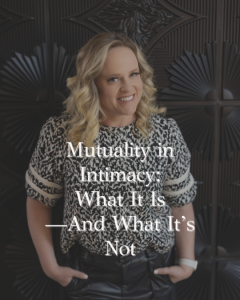
I’ve noticed a lot of people expressing problems with their spouse’s fantasies. They don’t understand certain fantasies, and they are afraid that their spouse wants to turn them into reality. But, there’s a difference between fantasy and desire. A fantasy is more about thoughts where a desire is bringing that thought into reality. Let’s talk more about the difference and what that means to your relationship in this episode.
Show Notes:
Follow Amanda on Facebook and Instagram.
Join Amanda’s Private Facebook Group.
Show Summary:
In some Facebook groups I’m in, problems with a spouse’s fantasy often come up as a topic of discussion. Spouse’s don’t always understand a certain fantasy, they are scared their spouse wants to turn it into reality, and they don’t handle it well.
So today, I want to dive into the difference between a fantasy and a desire. We’ll explore what each one is, why they’re different, how they’re developed, and what to do if they fall outside your value system. We’ll also look at common fantasies and desires, how to share them with your spouse, and what to do if your spouse isn’t receptive. So, let’s get started!
What is a Fantasy?
A fantasy is an imagined scenario that often involves sexual themes. These scenarios can range from the simple and sweet to the wild and adventurous. They might involve people you know, celebrities, or even fictional characters. Fantasies are often a safe way to explore your sexuality in your mind without any real-world consequences.
Fantasies allow us to escape reality for a moment and explore different aspects of our sexuality. For instance, you might fantasize about being swept off your feet by a dashing stranger, engaging in a passionate affair on a private island. This fantasy doesn’t mean you want to be unfaithful; it could simply reflect a desire for more excitement or adventure in your relationship.
Another common fantasy might involve role-playing. Imagine you’re a knight in shining armor rescuing your spouse from a dragon, and the two of you share a passionate kiss after the daring rescue. This fantasy might tap into themes of heroism, protection, and deep romantic connection.
What is a Desire?
A desire, on the other hand, is something you actively want to experience in real life. Desires are rooted in reality and often align with your personal and relational goals. They are things you might discuss with your spouse and hope to incorporate into your relationship.
For instance, you might desire to have a weekly date night to keep the romance alive in your marriage. This is a concrete, actionable goal that you can work towards together. Desires often involve mutual consent and shared values, making them more about enhancing your real-life connection.
Another example of a desire could be wanting to introduce more physical touch in your daily interactions. Maybe you want to hold hands more often, give each other massages, or cuddle before bed. These desires are all about deepening your physical and emotional bond in ways that are achievable and realistic.
Why Are They Different?
The key difference between fantasies and desires lies in their connection to reality. Fantasies are often not meant to be acted upon; they’re more about exploration and imagination. Desires, however, are actionable and involve real-life changes or experiences.
Let’s use an example: A fantasy might involve a scenario where you and your spouse are the stars of an old Hollywood movie, living out a glamorous, passionate romance. You might imagine yourself dressed in vintage attire, dancing under the stars in a grand ballroom. This fantasy allows you to experience a sense of nostalgia and glamor.
A desire, on the other hand, might be to have a date night where you both dress up in vintage clothes, watch an old movie, and recreate some of the romantic moments from the film. This desire is rooted in reality and can be planned and executed to enhance your relationship.
How Are They Developed?
Fantasies are developed through a combination of personal experiences, media consumption, and imagination. They can be influenced by books, movies, past experiences, or even random thoughts. Fantasies often reflect deeper psychological themes and can be a way to explore different aspects of your identity or your sexuality.
For example, a fantasy might develop after watching a romantic adventure movie where the couple escapes to a hidden paradise. This movie might spark your imagination, leading you to create elaborate scenarios in your mind where you and your spouse are the protagonists of your own adventure.
Desires, on the other hand, are often developed through your relationship experiences, communication with your partner, and personal growth. They evolve as you and your spouse learn more about each other and yourselves. Desires might stem from a longing for deeper connection, more intimacy, or new experiences together.
For instance, a desire might grow from ongoing conversations with your spouse about wanting to spend more quality time together. You might decide to plan regular weekend getaways or set aside time each evening to talk and connect. These desires are actionable and help strengthen your bond.
What If They Are Outside of Your Value System?
It’s not uncommon for fantasies to step outside of your value system. Because they are imaginary, they can explore boundaries and scenarios that you wouldn’t consider in real life. This is perfectly normal and doesn’t necessarily reflect your true desires or intentions.
If a fantasy or desire conflicts with your values, it’s important to understand that having these thoughts doesn’t define you. Instead, it can be a chance to explore why this particular fantasy or desire is appealing and what it says about your deeper needs or emotions.
For example, if you have a fantasy about a forbidden romance, it might not mean you want to be unfaithful. Instead, it could indicate a desire for more excitement or passion in your current relationship. Reflecting on these feelings can help you find ways to fulfill your needs within your value system.
It’s important to communicate with your spouse about these feelings in a non-judgmental way. Share your thoughts and explore together how you can bring more excitement or passion into your relationship without compromising your values.
Common Fantasies and Desires
Some common fantasies include:
- Role-playing different characters or scenarios: Imagine being a pirate and a captured maiden, or a teacher and a student.
- Being intimate in unusual places: Like a hidden forest, a rooftop, or even a library after hours.
- Engaging in power dynamics: Exploring dominance and submission in a safe, consensual way.
- Threesomes or group sex scenarios: While not necessarily something you’d want to act on, these fantasies can reflect a desire for variety or excitement.
Common desires might include:
- Trying new sexual activities or positions: Introducing new ways to connect physically and keep things exciting.
- Increasing frequency of intimacy: Wanting to make love more often to strengthen your bond.
- Building emotional intimacy and connection: Spending more time talking, sharing, and understanding each other.
- Exploring different forms of touch or massage: Incorporating more physical affection into your daily routine.
How to Share Them with Your Spouse
Sharing fantasies and desires with your spouse can be a vulnerable but rewarding experience. Here are some tips on how to do it:
- Choose the Right Time: Make sure you’re in a private, relaxed setting where you won’t be interrupted. Timing is crucial. For example, bringing up a fantasy during a heated argument is probably not the best idea. Instead, choose a time when you’re both relaxed, maybe after a nice dinner or during a quiet evening at home.
- Be Honest and Open: Share your thoughts and feelings openly, but also be mindful of your spouse’s feelings. Use gentle language and frame your desires in a positive light. For example, you might say, “I’ve been thinking about ways we can make our intimate moments even more special. I have a fantasy I’d love to share with you if you’re open to it.”
- Use “I” Statements: This helps to express your feelings without making your spouse feel defensive or that they are defective or insufficient. For example, “I’ve been thinking about how exciting it would be to try something new together,” instead of “You never want to try anything new.”
- Be Respectful: Understand that your spouse may have different reactions and that’s okay. They might need time to process what you’ve shared. Be patient and open to their perspective.
What to Do If Your Spouse Is Not Receptive
If your spouse isn’t receptive to your fantasies or desires, it’s important to respect their feelings and boundaries. Here are some steps to take:
- Listen to Their Concerns: Understand their perspective and why they might feel uncomfortable. For example, they might have past experiences or insecurities that make them hesitant. Listening without judgment can help you understand their viewpoint.
- Find Common Ground: Look for compromises or alternative ways to fulfill both your needs. If your spouse isn’t comfortable with a particular fantasy, perhaps there’s a different way to bring more excitement into your relationship that aligns with both your comfort levels.
- Reaffirm Your Love and Commitment: Ensure your spouse knows that their feelings and comfort are a priority. Reassure them that your primary goal is to enhance your relationship, not to push boundaries that make them uncomfortable.
- Seek Professional Help If Needed: They can help you navigate these conversations and find mutually satisfying solutions. They can also provide a safe space for both of you to express your feelings and work towards a deeper understanding.
Conclusion
Fantasies and desires are natural parts of our sexuality. Understanding the difference between them, how they develop, and how to communicate them with your spouse can enhance your intimacy and connection. Remember, it’s all about mutual respect, understanding, and finding ways to support each other’s needs and values.
Remember, love is a journey, not a destination. Stay committed, stay passionate, and stay connected. Goodbye for now.



